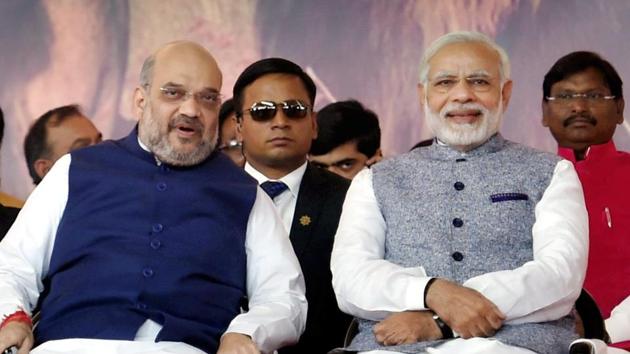At Vijay Rupani’s swearing-in, Gujarat BJP sees a reunion of sorts featuring PM Modi
The rift between Keshubhai, a Patidar; Vaghela, a Kshatriya; and Modi, an OBC, was seen as a representation of the equations between the three communities that have remained vital to the poll narrative in the state.
Minutes before Vijay Rupani began his second stint as Gujarat CM on Tuesday, BJP’s state politics appeared to have come full circle when three of its stalwarts — PM Narendra Modi, and former CMs Shankersinh Vaghela who has quit the party and Keshubhai Patel – came on the same stage, putting behind decades of rivalry.

When he reached the stage set up for the grand ceremony at Gandhinagar’s secretariat ground, Modi made it a point to spend extra time interacting with Vaghela and Keshubhai. He held their hands and spoke with a broad smile on his face.
The Prime Minister’s gesture was taken by political observers as an attempt to signal that the differences that had crept between the three leaders over 20 years have been erased. Their fierce rivalry was held accountable for the toppling of BJP’s first Gujarat government within years of its formation in 1995.
Community politics
The tussle between the three pillars of party’s Gujarat unit was taken to be an extension of the community-driven politics that continues to govern Gujarat.
The rift between Keshubhai, a Patidar; Vaghela, a Kshatriya; and Modi, an OBC, was seen as a representation of the equations between the three communities that have remained vital to the poll narrative in the state.
“Modi earned the title of ‘Super CM’ when he was an organisational secretary in BJP’s first Gujarat government in 1995 with Keshubhai at the helm. Vaghela then rebelled and formed his own government, with the Congress’ support, in 1997. In a way, Modi was held responsible for sabotaging the BJP government,” political analyst Hari Desai said
He, however, added that Modi took a step towards changing that notion. “By holding their hands, the message Modi sent out was that he has brought back the two veterans who equally share credit for building BJP’s base in Gujarat’’, Desai added.
History of rift
Keshubhai, who was unceremonious ousted from the chief minister post in 2001 to make way for Modi, held the PM guilt of plotting his removal. He took over a decade to stage his rebellion and tried to take on Modi in the 2012 elections by forming the Gujarat Parivartan Party. His party, however, could manage to win only two seats.
The 89-year-old leader eventually accepted Modi’s leadership when he became the Prime Minister in 2014 and resigned as an MLA, following which his party was dissolved.
Vaghela, analysts said, always considered Modi to be his rival within and outside the BJP. He proved his mettle by forming the government with the support of BJP rebels and the Congress in 1997. But when his Rashtriya Janta Party tasted defeat in 1998, he merged it with the Congress.
Before this year’s polls, Vaghela parted ways with the Congress along with six of his loyal MLAs. Eight other Vaghela supporters cross voted in the Rajya Sabha elections held in August, providing the BJP with an opportunity to prevent veteran Congress leader Ahmed Patel from retaining his seat.
“After the Rajya Sabha polls, Vaghela was seen as BJP’s B team. Though he worked against the Congress and made peace with Modi, one cannot say for sure that both the leaders have regained each other’s trust’’, Desai said.
PM has the last laugh
Political observers were quick to point out that the while the ties between the three leaders might have been ‘restored’, Modi has undoubtedly had the last laugh. “Both Vaghela and Keshubhai have been politically nullified and Modi has emerged as BJP’s supreme leader,” Desai said.





